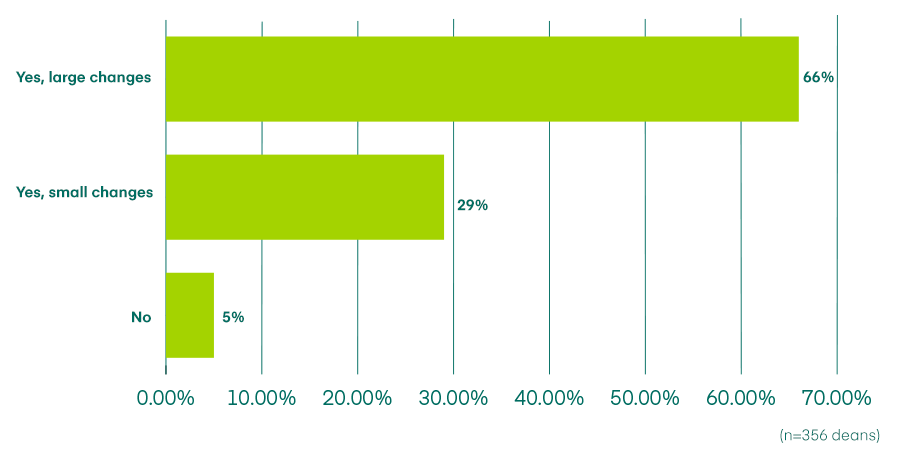B-School Leaders Reflect on a Year of Change
Business schools were put to the test this past year, navigating in rapidly changing market conditions brought on by the pandemic. Schools had to pivot to bring their courses online; accommodate new needs of students, faculty, and staff; and address financial shortfalls. Deans, as the heads of business schools, are often at the center of these decisions and, along with their senior administrators and faculty, have had to make a lot of difficult choices to circumnavigate the many, varied obstacles they encountered through the year.
To get a better sense of what these challenges were, we added a section to our triennial survey of deans at AACSB member schools. The overall survey received participation from 356 deans representing 56 countries and territories. We asked deans directly if the pandemic had an impact on their own duties.
Figure 1. Has the Pandemic Had an Impact on Job Duties?—Deans

Overwhelmingly, the answer was yes—with as many as two-thirds reporting large impacts on their job duties.
In a separate survey of senior business school administrators at AACSB member schools, primarily made up of assistant, associate, and vice deans, we asked the same question.
Figure 2. Has the Pandemic Had an Impact on Job Duties?—Senior Administrators

While a similar count of senior administrators acknowledged at least some changes to their job duties, about 16 percent fewer administrators than deans indicated large changes, with a greater proportional number reporting small changes compared to those reported by deans.
We asked deans to share what the most challenging aspects of the pandemic have been related to their own job duties. Here are some of the responses that appeared most frequently:
- Risk and crisis management: While some deans have had to manage during a crisis before, this was a new experience for many deans.
- Managing morale, of both faculty and students: Many deans experienced new challenges in motivating students to continue with their studies, and faculty to try out online teaching and experiment with new modalities.
- The transition to remote work for staff and students: This transition represented a sizable hurdle for many schools, in terms of resources, time, training, and more.
- Having to generate new sources of revenue: Whether through calling alumni for donations, working on fundraisers, and other such activities, revenue generation was a challenge for many deans.
- Recruiting students: Several deans shared the need to recruit students from new locations. For instance, if a school would typically recruit internationally, and this was no longer an option due to travel restrictions, deans had to pivot their focuses to more local areas. Additionally, new populations of candidates, who previously may not have applied due to location or time constraints, could now be targeted. With these barriers removed in the switch to online courses, deans needed to refocus their recruitment strategies.
Senior administrators echoed many of these sentiments, though their most frequently cited challenges tended to focus more on teaching and engagement, as many of these administrators also maintained an active faculty role. Remaining engaged with students while working remotely, transitioning coursework online, managing a remote staff, and dealing with hiring freezes were the most prominent challenges named by senior administrators.
While these challenges were tough and varied for deans, some positives that resulted from the trials, or silver linings, were also shared.
- Needed investments in technology made: Some deans shared that their schools were incentivized to make needed investments in technology to support new learning modalities.
- Faculty adoption of online learning: Faculty and staff were given a crucial push to dive into online teaching and to experiment with new strategies and pedagogy.
- Improved work-life balance: Deans shared that their work-life balance had been improved, as they had more time at home and less time on the road due to travel restrictions.
A silver lining noted by many senior administrators was the accelerated use of digital technologies for faculty (online delivery of course content) and staff (remote work processes), as well as accelerating some greater acceptance of "change,” somewhat generally, throughout the university. Senior administrators also shared that they had more time to focus on their core role, with fewer disruptions or distractions.
While it is likely that many respondents would welcome some normalcy, the many positive changes that resulted from the pandemic do help offset, at least to some degree, the weight of the difficulties from the year.
